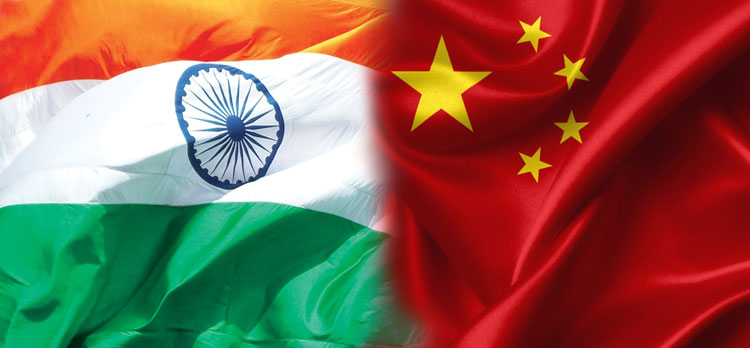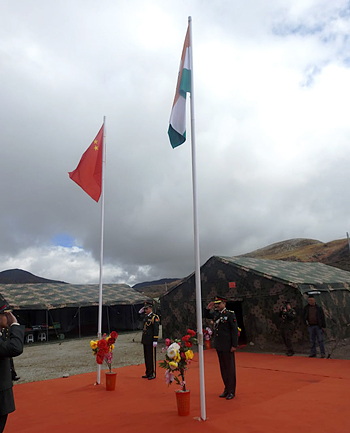INDIAN ARMED FORCES CHIEFS ON
OUR RELENTLESS AND FOCUSED PUBLISHING EFFORTS

SP Guide Publications puts forth a well compiled articulation of issues, pursuits and accomplishments of the Indian Army, over the years

I am confident that SP Guide Publications would continue to inform, inspire and influence.

My compliments to SP Guide Publications for informative and credible reportage on contemporary aerospace issues over the past six decades.
- Prime Minister witnesses 'Bharat Shakti' – a Tri-Services Firing and Manoeuvre Exercise in Pokhran, Rajasthan
- Interim Defence Budget 2024-25 — An Analysis
- Union Defence budget 2024
- Prime Minister Modi Commemorates Indian Navy Day in a Grand Ceremony
- Prime Minister Modi Flies in the LCA Tejas
- New Chapter in India-Italy Defence Ties
- Airpower beyond Boundaries
13th India-China Military Talks
During the meeting, the Indian side made constructive suggestions for resolving the remaining areas but the Chinese side was not agreeable and also could not provide any forward-looking proposals. The meeting thus did not result in resolution of the remaining areas.
 |
The Author is Former Director General of Information Systems and A Special Forces Veteran, Indian Army |

Number 13 is considered an unlucky number in India and so were the 13th Corps Commander-level talks between India and China held in Eastern Ladakh on October 10, 2021; ending in zero progress and on somewhat acrimoniousnote with both sides blaming each other.
Post the meeting, the Indian Army statement issued read: “The 13th round of India-China Corps Commander Level Meeting was held at Chushul-Moldo border meeting point on October 10, 2021. During the meeting the discussion between the two sides focused on resolution of the remaining issues along the LAC in Eastern Ladakh. The Indian side pointed out that the situation along the LAC had been caused by the unilateral attempts of Chinese side to alter the status quo and in violation of the bilateral agreements. It was therefore necessary that the Chinese side take appropriate steps in the remaining areas so as to restore peace and tranquility along the LAC in the Western Sector. This would be in accord with the guidance provided by the two Foreign Ministers in their recent meeting in Dushanbe where they had agreed that the two sides should resolve the remaining issues at the earliest. The Indian side emphasised such resolution of the remaining areas would facilitate progress in the bilateral relations. During the meeting, the Indian side therefore made constructive suggestions for resolving the remaining areas but the Chinese side was not agreeable and also could not provide any forward-looking proposals. The meeting thus did not result in resolution of the remaining areas.
The Indian side pointed out that the situation along the LAC had been caused by the unilateral attempts of Chinese side to alter the status quo and in violation of the bilateral agreements
The two sides have agreed to maintain communications and also to maintain stability on the ground. It is our expectation that the Chinese sidewill take into account the overall perspective of bilateral relations and will work towards early resolution of the remaining issues while fully abiding by bilateral agreements and protocols.”

Looking at the above statement, any military-man would tell you that this is not Army’s language but response worked out by our diplomats, perhaps even before the meeting knowing that there would be no progress. The Chinese side appears to have signaled no more disengagement, which is evident from the statement of Colonel Long Shaohua, spokesperson for PLA’s Western Theater Command (WTC) on October 11 saying, “Instead of misjudging the situation, the Indian side should cherish the hard-won situation in China-India border areas.”
Shaohua said, during the meeting the Chinese side made great efforts to promote the easing and cooling of the border situation and fully demonstrated China’s sincerity of maintaining overall interests of bilateral military relations. However, the Indian side still persisted in its unreasonable and unrealistic demands, which added difficulties to the negotiations. He further said that China is firm in its resolve to safeguard national sovereignty – which obviously includes all its illegal claims to territory.
Notably, the 13th round of talks was sought by India while China took its own sweet time to agree to hold the discussion. Post the meet, the Indian statement is mellowed in admitting that the talks were useless but the Chinese statement emphasises that China is firm in its resolve to safeguard national sovereignty. This indicates that while talks can continue, Chinawill not move back any more. This was evident anyway with the permanent structures and surveillance towers the PLA has already erected in their new locations.
The Chinese statement emphasises that China is firm in its resolve to safeguard national sovereigntywhich indicates that while talks can continue, China will not move back any more
The fact remains that during the aggression in Eastern Ladakh last year the Chinese not only came to their 1959 claim line (which India had never recognised) but in many areas crossed over to the west of it. If the handling of the LAC by our diplomats left much to desire earlier, it touched bedrock after the PLA advance and occupation of new positions. The diplomatic advice to the government should have been to call a spade a spade and show to the world where all China had intruded across the LAC – just like the Pakistani intrusions were exposed in Kargil Sector during 1999.
Had the Ministry of External Affairs so advised the government, latter would have in all probability agreed because without any worthwhile opposition there was no danger of the government falling. Besides, the fragmented opposition noises could have been doused calling them anti-national; forcing them to join forces with the ruling dispensation for meeting the Chinese challenge.
Instead, the diplomats chose to obfuscate intrusions as ‘friction points’ without blaming China for the aggression. This encouraged China to blame India as the aggressor from the very beginning. To top this, we vacated the Kailash Range in our own territory of our own volition, losing the only leverage we had at the bargaining table. One possible reason could be that the Chinese foreign minister threatened his Indian counterpart that if we do not do so, PLA will attack in force our only post along the northern bank of Pangong Tso Lake (Dhan Singh Thapa Post) - and we succumbed to the threat?
The diplomatic advice to the government should have been to call a spade a spade and show to the world where all China had intruded across the LAC
Presently, we have a 10-km long no-patrol zone along the north bank of Pangong Tso, 5-km long no patrol zone in Gogra, eye-to-eye in Hot Springs area, PLA structures at Y-Junction 20-km inside our territory denying our patrols access to multiple patrolling points which anyway are short of the LAC, and PLA intrusion in Demchok. The Chinese stance has notably hardened in recent months with PLA also undertaking reconnaissance in force in areas of Barahotiin the Central Sector and Arunachal Pradesh.
We appear to have bound ourselves in the diplomatic web of our own making. The simple question is that if we say that not even one inch of territory has been lost, what are the discussions about and why should China budge even one inch? How the situation will pan out in coming months is difficult to forecast but the Chinese stance is unlikely to soften.





